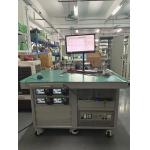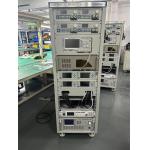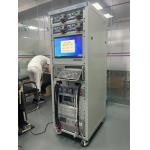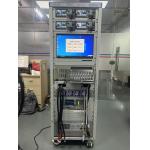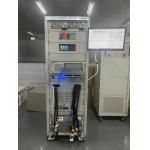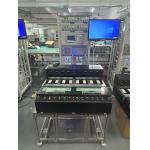Test system Charger & Adapter Power Auto Test System ATE Test
Equipment Benefits of Power Test Systems: Accurate Measurement of Electrical Parameters - Voltage Measurement: It can precisely measure the output voltage of a power supply,
ensuring it is within the specified range, thus guaranteeing stable
power for electrical equipment. For example, for precision
electronic devices that have strict voltage requirements, accurate
voltage measurement can prevent damage or performance degradation
due to excessively high or low voltages.
- Current Measurement: Accurately measuring the output current of a power supply helps
understand its load capacity. When testing a power supply's ability
to power different devices, current measurement can determine
whether the power supply can meet the device's current demands,
avoiding malfunction or overload protection caused by insufficient
current.
- Power Measurement: Accurate measurement of the output power is crucial for assessing
the capacity and performance of a power supply. Through power
measurement, one can determine whether the power supply can provide
sufficient energy for connected devices and also monitor its
working efficiency under different load conditions.
Rapid Diagnosis of Faults - Short Circuit Detection: A power test system can quickly detect short circuit faults at
the power supply output. In complex circuit systems, short circuits
can cause a sudden increase in current, leading to equipment damage
or fire hazards. The power test system can promptly issue an alarm,
helping engineers quickly locate and resolve short circuit issues.
- Open Circuit Detection: It detects whether there is an open circuit fault at the power
supply output. An open circuit will prevent equipment from
receiving normal power. The testing system can quickly determine
the location of the open circuit, facilitating repairs and
restoring power.
- Fault Location: When a power supply malfunctions, the test system can accurately
locate the fault point through testing and analysis of various
parameters. For instance, it can determine whether the fault is due
to internal component damage, circuit connection issues, or
external load problems, helping maintenance personnel quickly solve
the problem and reduce equipment downtime.
Ensuring Product Quality and Stability - Consistency Testing: During production, batch testing of power supplies of the same
model can ensure that each unit's performance and quality are
consistent. By statistically analyzing test data from multiple
samples, production process issues or material differences can be
identified in a timely manner, allowing for corresponding
adjustments to be made, thereby improving product consistency and
reliability.
- Reliability Evaluation: Through long-term stability tests and aging tests, the
reliability of a power supply under different operating conditions
and load conditions can be evaluated. This helps screen out
products with unstable quality, improve the overall quality level
of the product, and reduce the failure rate during use.
Optimizing Power Supply Performance Design - Efficiency Testing: Accurately measuring the efficiency of a power supply helps
engineers understand its energy conversion efficiency under
different loads and working modes. By analyzing efficiency data,
energy consumption issues in the power supply design, such as
components with excessive losses or unreasonable circuit
structures, can be identified, allowing for optimization of the
design and improvement of the power supply's energy efficiency.
- Dynamic Response Testing: Assessing the response speed and stability of a power supply to
load changes is important. In practical applications, many devices
experience rapid load changes during operation. Good dynamic
response capability ensures that the power supply can adjust its
output in a timely manner to maintain stable power supply. Dynamic
response testing provides a basis for improving the power supply
design, enhancing its adaptability to load changes.
Simplifying Test Processes and Improving Efficiency - Automated Testing: Power test systems typically have automated testing functions and
can complete various testing tasks automatically according to
preset procedures and parameters. This not only reduces the
workload and errors of manual operations but also improves testing
efficiency, especially suitable for large-scale production and
batch testing scenarios.
- Data Recording and Analysis: Automatically recording various data during the testing process
and performing data analysis and processing. Engineers can quickly
understand the performance characteristics and trends of the power
supply through data analysis and comparison, providing strong
support for product improvement and optimization. At the same time,
data recording also facilitates subsequent quality traceability and
after-sales service.
Test Items of Mobile Power Supply Testing System: Input test | Charge test | | Input voltage ramp | Charge current test | | Input freq. ramp | Full charge testing | | AC cycle drop out | slow charge test | | Input power supply distortion mode | Slow Charge ID setting test | | Input RMS current | Discharge while charge test | | input power | Electricity indication test | | Input power factor | Simulation battery function | | Input peak current test | Wireless charging test | | Output test | Timing / dynamic test | | DC output voltage | Turn ON time | | DC output current | Rise time | | Power up sequence | Fall time | | Power off sequence | Hold-up time | | Tracking | Special test | | Efficiency test | LED lamp voltage and status test | | Overshoot voltage test | LED flashing frequency test | | Peak-Peak noise | Sleep mode test | | Stability test | D + / D-voltage test | | Voltage regulation | MCU communication and calibration tests | | Current regulation | Discharge test | | Mixed effect test | GPIB read/write | | Protection test | USB read/write | | Short circuit test | RS232 read / write | | OV protection | TTL signal control | | UV protection | Relay control | | Charge protection test | Bar code scan | | Discharge protection test | Extended measurement function | | Overcurrent protection test | | | Fast charge test(Applicable to QC2.0, QC3.0 and other fast charge
test) | |
|
